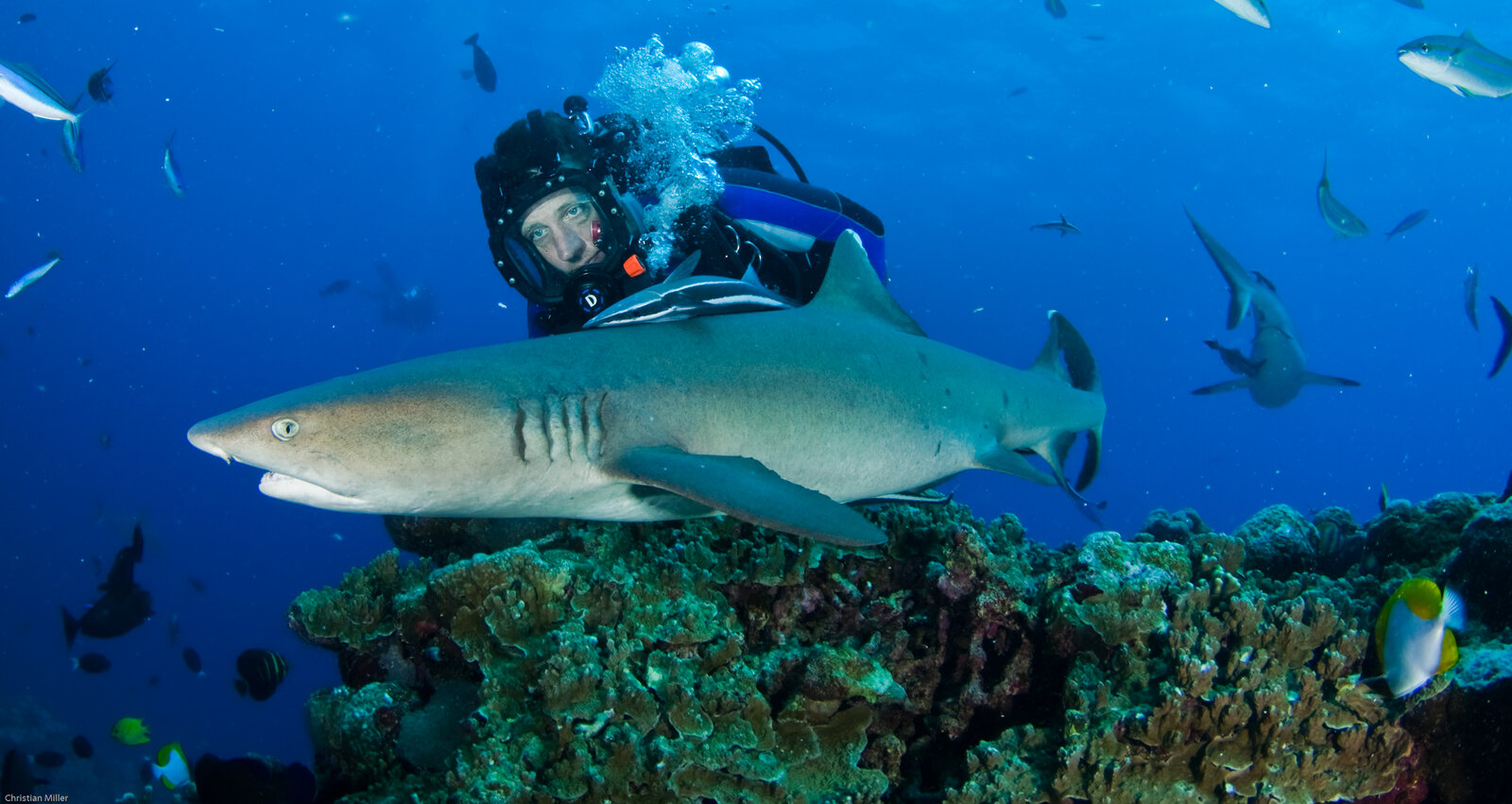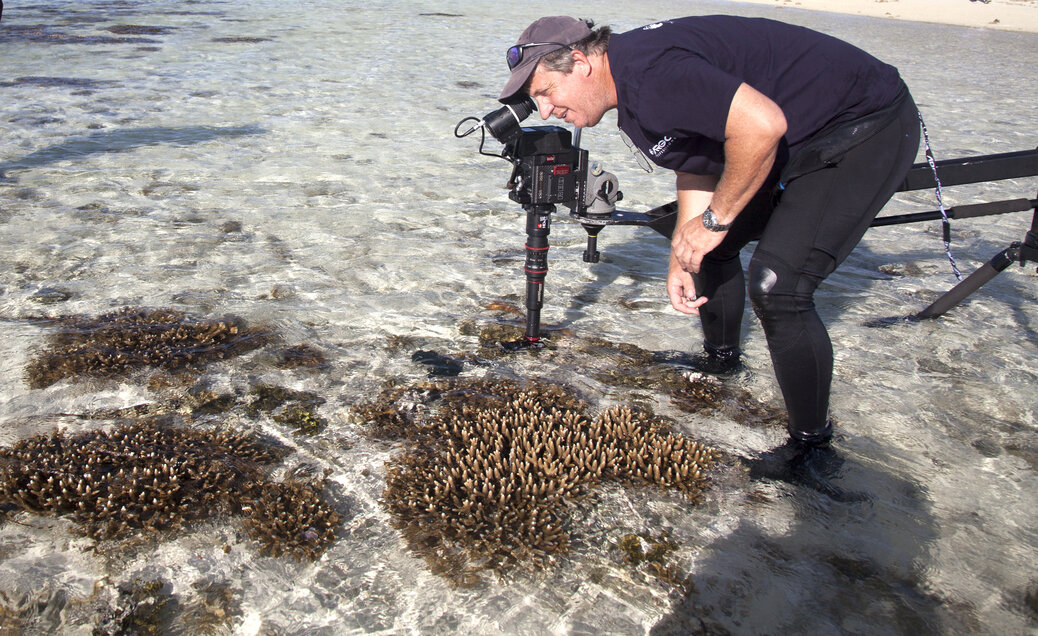
Words By Maura Mancini
It began with tail-roping sharks, not from the deck of a commercial fishing vessel, but underwater and bare-handed. In the 1990s, off the coast of Port Douglas, a young marine biologist named Richard Fitzpatrick was tagging sharks without hooks, aiming to cause minimal stress or harm to the animal.
He was aboard the Undersea Explorer, a research and ecotourism vessel helmed by the late John Rumney, a renowned conservationist and pioneer of sustainable tourism on the Great Barrier Reef. In those early days at Osprey Reef, one of the Coral Sea’s most pristine dive sites, Fitzpatrick’s passion for marine science soon merged with a growing talent: capturing the underwater world on camera.
“Other production crews might spend weeks waiting for the right weather. We’re already out there. When the sharks show up, we’re rolling.”
Fast-forward three decades, and Fitzpatrick is now one of the world’s most respected underwater cinematographers. An Emmy Award winner, he is the co-founder of both Biopixel and the Biopixel Ocean Foundation, together with Queensland IT entrepreneur Bevan Slattery. Both organisations are based at the James Cook University Cairns facility, where Fitzpatrick also works as an Adjunct Research Fellow.
He has filmed over 150 major documentaries for leading networks including National Geographic, the BBC, Discovery Channel, Netflix, and Disney.
His footage appears in acclaimed productions such as David Attenborough’s Great Barrier Reef, Welcome to Earth with Will Smith, Planet Earth III, Life on Our Planet produced by Steven Spielberg, and Supernatural by James Cameron.
But for Fitzpatrick, the goal is not just entertainment. His work shapes marine policy, supports global science, and transforms how we understand and protect our oceans.
“Sharks are a keystone species,” he says. “They’re essential to healthy oceans, and their presence influences the entire balance of marine life.”
Science Beneath the Surface
Fitzpatrick’s shark-tagging techniques were unconventional for their time. Rather than using lines or hooks, he would dive with the animals and gently tail-rope them during feeding dives. This allowed him to surgically implant acoustic tags and attach data loggers before releasing the sharks unharmed.
The high-risk approach demanded not only expert knowledge of shark behaviour but also calm underwater handling skills and a deep commitment to animal welfare. Once tagged, sharks were monitored via a network of underwater listening stations that recorded their movements.
“I came from a background working with animals in aquariums,” he explains. “I was used to handling them carefully and directly. I didn’t want to hurt the sharks, so I learned how to catch them by the tail.”
Working alongside researchers from James Cook University, Fitzpatrick uncovered important patterns in shark behaviour. Their studies showed that many tagged sharks returned repeatedly to a fish-rich, sheltered zone in the north-western corner of Osprey Reef. This revealed that while sharks roam widely, they rely on specific habitats, making those areas especially critical to protect.
These insights provided some of the first detailed movement data on reef sharks and helped inform the creation of the Coral Sea Marine Park, a vast protected zone adjacent to the Great Barrier Reef. Unlike earlier marine parks, which were based solely on habitat types like coral reefs or mangroves, this body of work showed that many species cross these boundaries.
For conservation to be effective, it must reflect how marine animals actually move, through interconnected zones or migration corridors.
“You can’t just guess,” Fitzpatrick says. “You need published science to support conservation decisions. Our data helped shape zoning systems in the Coral Sea and beyond.”
Their work highlighted the need for connected, flexible marine reserves, zones that reflect how animals actually live, move and migrate and helped shift how marine conservation is approached in Australia and internationally.
Vision in Motion
Fitzpatrick’s path diverged from traditional academic researchers early on. While filming captive marine life for behavioural studies, he discovered a fascination with visual storytelling and its power to bring science to wider audiences. Today, he leads Biopixel TV, one of Australia’s foremost natural history production companies. His archive contains some of the most vivid and intimate underwater footage on record.
What began as a scientific tool evolved into a platform for change. Fitzpatrick is now renowned for capturing complex marine behaviours using advanced filming techniques such as 3D, high-speed, time-lapse, motion control, drone, and underwater cinematography—many of which pioneering their use in underwater settings.
Biopixel is turning the traditional film model on its head. The concept is simple: film the science in real time and use the footage for education, conservation and broadcasting.
“We film the research as it happens,” Fitzpatrick says. “So when producers come knocking, we already have the footage, captured in ideal weather, using top-end digital cinema cameras like REDs. No wasted weeks offshore waiting for nature to cooperate.”
This approach has built Biopixel’s extensive high-resolution marine footage library, available for both scientific and commercial use.
“Other production crews might spend weeks waiting for the right weather. We’re already out there. When the sharks show up, we’re rolling.”


